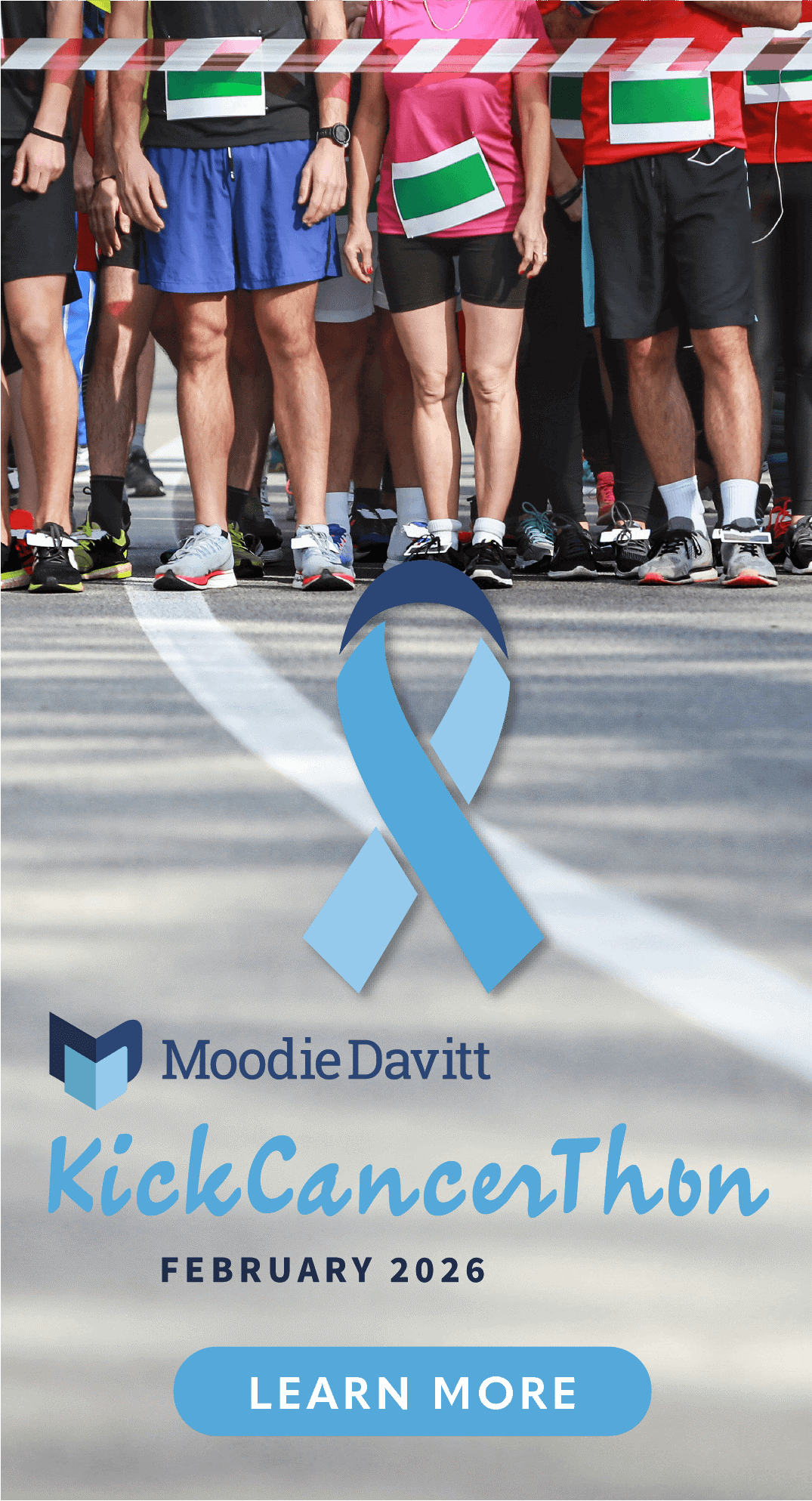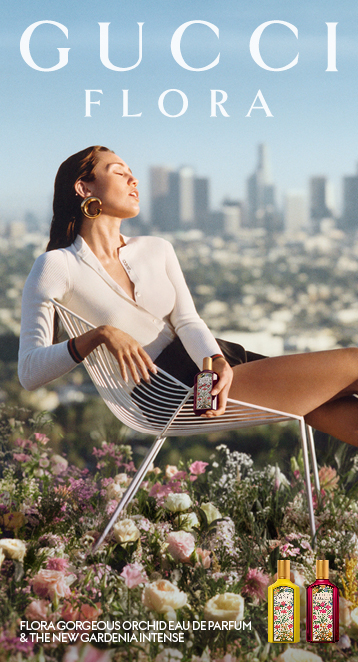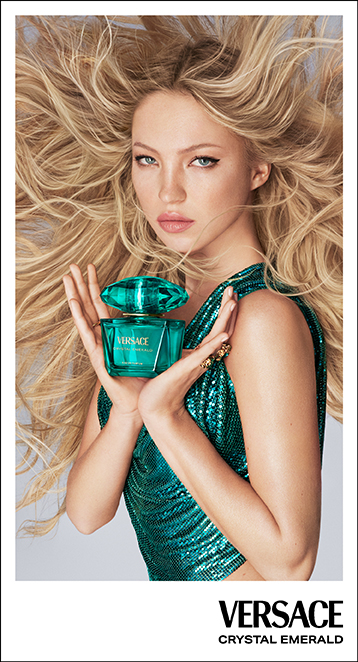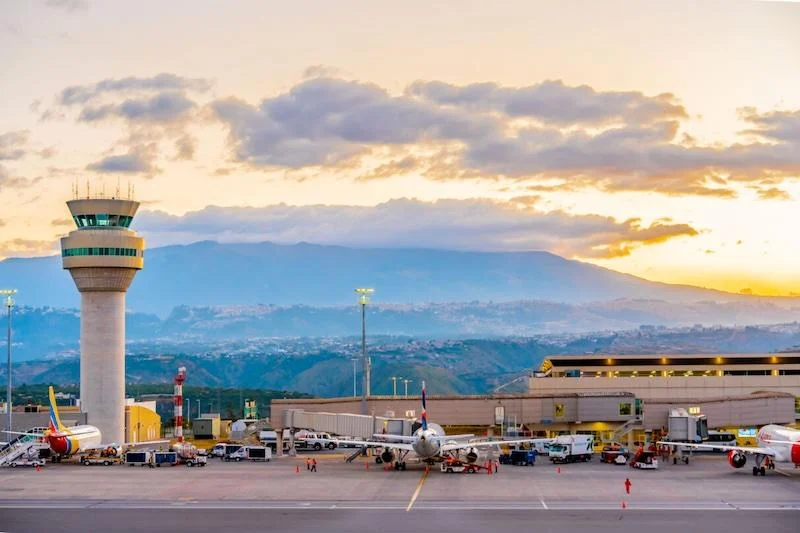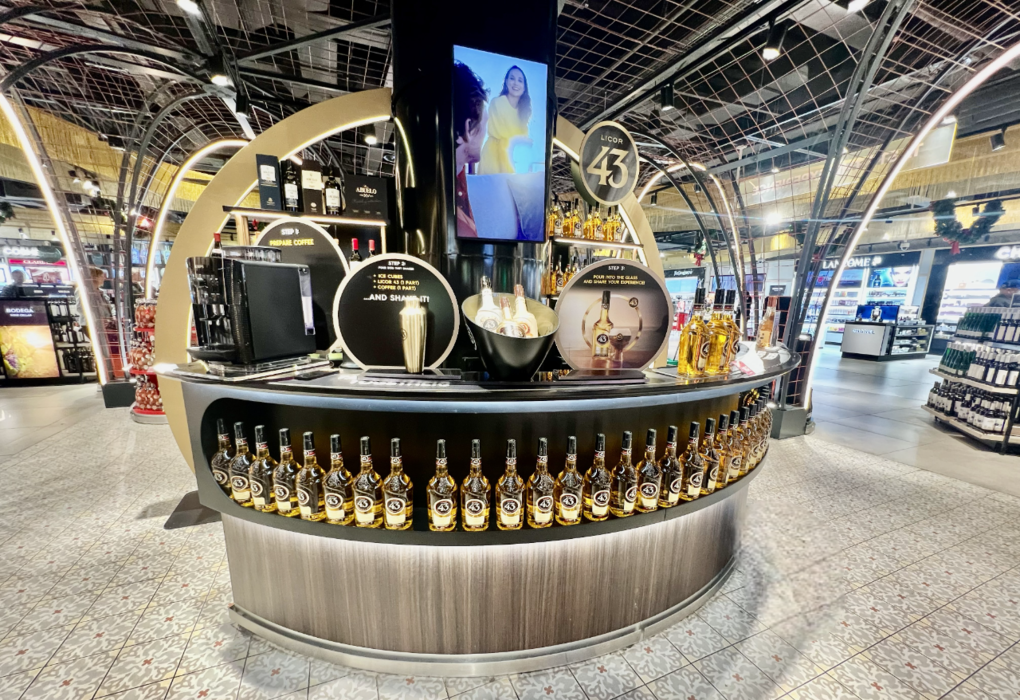Prologue: Over recent months, Dubai Duty Free has radically revamped its arrivals shopping offer at Dubai International Airport (DXB) across terminals 1, 2 and 3.
The multi-million-dollar renovation project, which began in April 2024, covered over 2,171sq m or 54% of the company’s arrivals retail space.
The store refurbishments, which follow the impressive redevelopment of the main T3 arrivals store in 2020, are designed to improve visibility and accessibility to drive penetration.
The Moodie Davitt Report Founder & Chairman Martin Moodie toured the new-look stores with Dubai Duty Free Managing Director Ramesh Cidambi last month, filming them courtesy of our Moodie Davitt STUDIO* division and discovering more about the transformational impact of the project.
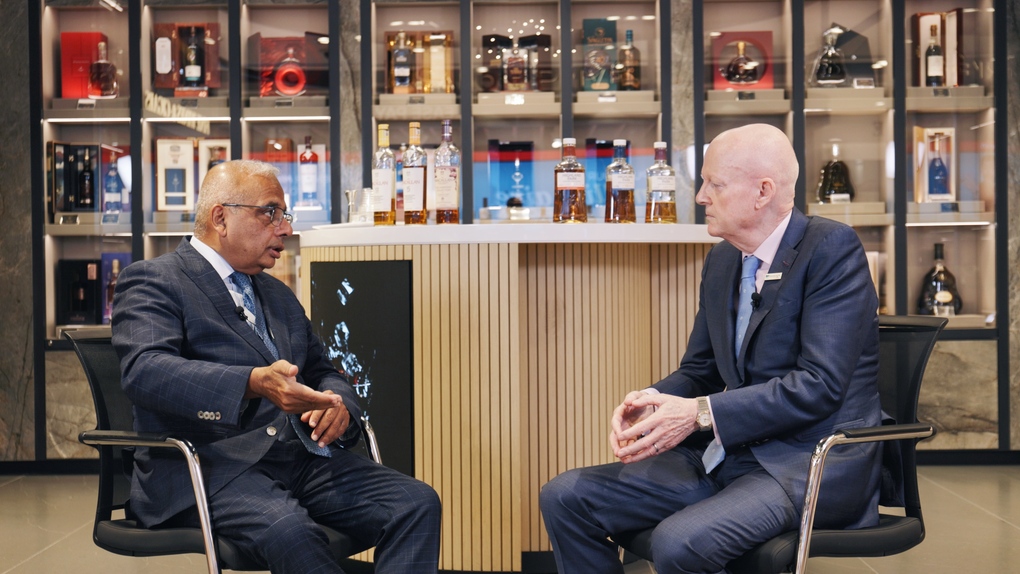
Arrivals shopping has long been an integral element of the Dubai Duty Free retail proposition, thanks largely to high domestic taxes on alcohol and a large ex-patriot base.
But over recent times a series of challenges have placed pressure on the business, prompting the need for a rethink and the subsequent ambitious overhaul of the T1 and T2 shops and one of the two T3 stores.
“The arrivals offer at Dubai Duty Free encompasses approximately 2,400 square metres in terminals 1, 2 and 3,” explains Managing Director Ramesh Cidambi. “The challenge for us was that the Dubai government removed the domestic tax on alcohol in January 2023.
“So, our arrivals offer had to respond to the increased level of competition from [local market retailers] African + Eastern and MMI, continued competition from the northern Emirates, and improvements in the Indian airports’ retail offer.
“Passengers heading to Indian airports represent 13% of our business and sales to Indian passengers are a significant part of our alcohol category. All of this competitive pressure led us to start a sweeping revamp of the arrivals offer in T1, T2 and T3.”
Cidambi describes with a wry smile the “masochist” decision to revamp all three terminals’ stores simultaneously, as he emphasises the complexity and demands of such a programme.
“We had to work closely with the airport because of fire regulations, safety regulations and things like that,” he explains. “Once we got the concepts approved, we put up the hoardings for the first time in the three shops between March, April and May 2024. It took us 12 months approximately to finish. The last hoardings came down last month.
“During the renovation process, it was very painful. When the shop is in the middle of a renovation, the retail offer is very challenging. Firstly, for the passengers because let’s say a third to a half of the shop is under renovation. The references which would have filled up a full shop are now squeezed into half the space.
“And for Michael [Schmidt, Senior Vice President – Retail] and the retail team, it is very challenging because they have to maintain a high level of service. Merchandising is very difficult and replenishments are very difficult in a congested amount of space.
“As you have seen, the arrivals offer in Terminal 1 is only 600 square metres. Imagine you have half the shop behind hoarding – that makes it very challenging.
“We estimate that we lost about 25% of our turnover during the course of the renovation. But what we have after a year of pain and blood and sweat is a much superior retail offer. And we have a much better ability to compete with the domestic retailers in Dubai, with the Indian airports and with other airports that feed passengers into Dubai.”
External visibility and clear internal signage are hallmarks of the revamp, both essential elements when catering to a time-pressed traveller base, Cidambi says.
“Segmentation is very important and we try to do a good job with the lighting and the signposting. With the diversity of products and the diversity of arriving passengers, the products have to be showcased well.
“The way we now present the products and the labelling within the shops makes navigation much easier. In T3, for example, because we have 1,300 square metres, if you choose to have your bags with you, you can still navigate comfortably.
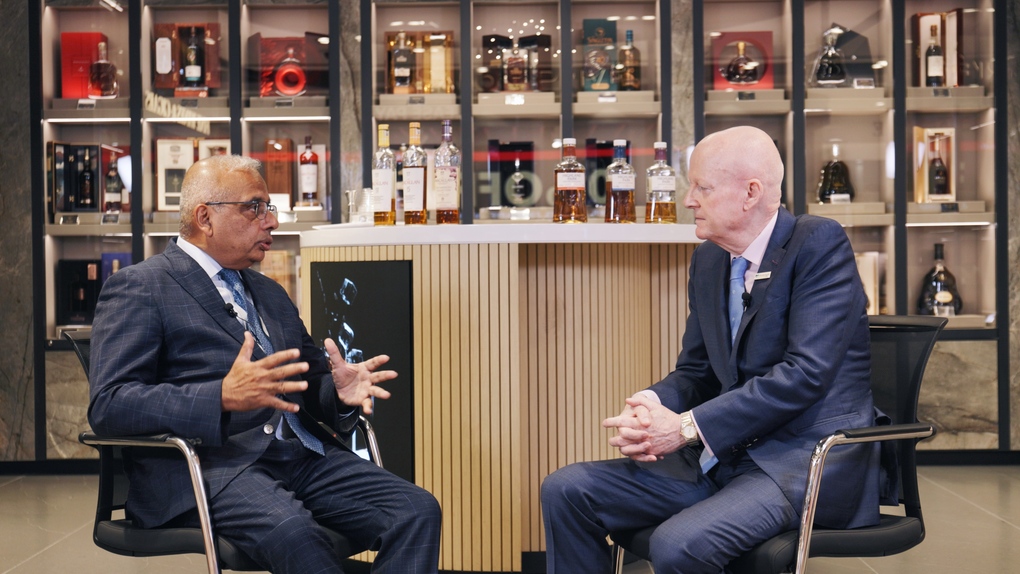
“Overall, because of the segmentation and the adjacencies, passengers should be able to find what they are looking for easily, because the first thing that the passenger thinks of when he or she lands is getting home or to their hotel.
“There are people who shop by habit and for them you need to have a good range and compelling promotions. But we also need to attract the people who are in two minds. ‘Shall I spend five minutes going into the shop or shall I just go straight home?’
“Elements such as the striking store fascias, the digital screens, Les Caves de Champagne at the front of the T3 store, the signposting and the lighting all contribute to the attractiveness of the offer and encourage people to walk through the threshold and come into the shop.”
Not every country has arrivals duty-free and where it is long-established, such as in the UAE, the concept has principally been built on large savings over local market prices. That advantage has been eroded by the scrapping of the local market alcohol tax but Cidambi says such challenges need to be embraced rather than used as an excuse for poor performance.
“Retail is a competitive business. All of us are adults, we are not babies. And when you have a change in the competitive situation, you have a duty to respond,” he comments. “It’s challenging in airports because of the amount of time that it takes to go from thinking of a project to eventual realisation, which is typically 18 months.
“So during those 18 months, you need to hold your nerve, you need to be calm and you need to get through the pain. Because what is at the other side is a much better offer.”
*About Moodie Davitt STUDIOMoodie Davitt STUDIO is a division of The Moodie Davitt Report, one of the world’s most successful multi-media business-to-business publishers, specialised in providing information of the highest quality to the global aviation and travel retail sectors. Moodie Davitt STUDIO productions feature a wide variety of formats and subject matter, from 60 to 90-second shorts designed for multiple social media channels to longer documentaries and series to be shown across our and clients’ platforms. The films are fronted by The Moodie Davitt Report Co-Owners Martin Moodie and Dermot Davitt, while production is led by Videographer, Editor and Director Alexander Roux, based in Hainan, China. *For partnership enquiries please reach out to: Martin Moodie: Martin@MoodieDavittReport.com (Content) Irene Revilla: Irene@MoodieDavittReport.com (Sales) |
There was encouraging precedent for such an approach. DDF had opted for a simultaneous refurbishment of its key Concourse B East and West liquor & tobacco departures stores last year. And it also did so with its popular Foodplus shops during the COVID-19 pandemic.
“We are really happy with the Concourse B liquor & tobacco shops and the Foodplus offer there is now fantastic,” Cidambi observes. “Renovation is expensive both from a capex point of view and in reducing your turnover while you’re doing it. But it’s much better in the end when you finish.
“The arrivals store project is also important because the offer is the first [retail] touch point for a new tourist coming into Dubai.
“They have all likely heard about Dubai Duty Free as we have very good name recognition. But if somebody arrives for the first time in Dubai, our stores have to reflect our reputation. And it should not be too far away as an experience from the departures offer, which I think we have been able to achieve.”
So if investment is about return, how are early results shaping up? “The numbers are positive. This month [June], for example, we are up +17.4% in the arrivals business,” Cidambi replies, speaking on 17 June, four days after the Iran and Israel conflict began, prompting a series of flight cancellations .
That crisis aside, arrivals sales growth is outstripping that of departures, clear confirmation of the strategy. And it’s not just a numbers story.
“Our employees are extremely happy with the quality of the retail offer and we are getting very good comments from passengers,” Cidambi observes.
“Friends of mine whom I haven’t heard from in months, text me and say our Champagne offer is fantastic or something else about the arrivals. So the word of mouth is very good.
“We will see in the next three to four months whether we are able to push the penetration up. That is what will eventually determine the success or failure of the project. We have been hanging around the 6-7% mark in terms of penetration in arrivals. We need to get that higher.
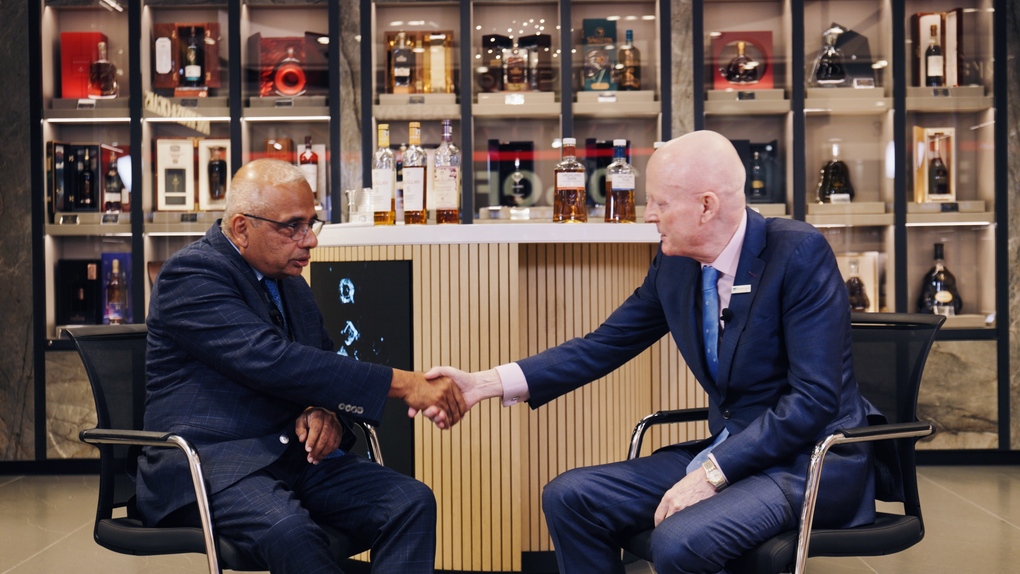
“It will never reach the 25% that you see in departures as the mindset of a passenger who’s arriving into a country and heading home is very different from that of a passenger who’s starting a journey in departures. But can six become seven? Can it become eight? That’s what we are trying to do.”
Cidambi first worked with Dubai Duty Free as a consultant in 1987, joining the executive team the following year. Over those nearly four decades, how does this project rank in terms of ambition and scale?
“Obviously the likes of the Concourse D opening in 2016; the Concourse A opening in 2013; and the Concourse B opening in 2008 were highly ambitious projects,” he responds.
“This project was more complicated from the point of view of taking an existing location, in which we are trading 24 hours a day. It also focused on alcohol, a category which is very important to us – 38% of all alcohol we sell is in arrivals.
“So for that category the arrivals offer is extremely important. This is therefore an important project in terms of responding in a positive way to competition from the domestic market. And in terms of capex and in terms of scale, it would be a top ten in the history of the company.”
Given Dubai Duty Free’s extraordinary narrative of success and development over its near 42-year history, that top ten status underlines the importance of the multi-pronged arrivals project.
Now it’s all a question of results. ✈
A Terminal Trilogy
Terminal 1 talking points
• Renovation of the 586sq m Terminal 1 store was completed a few weeks ago, a key concluding landmark to the whole arrivals shopping renovation.
• The design aims to showcase a seamless, visually appealing shopping environment.
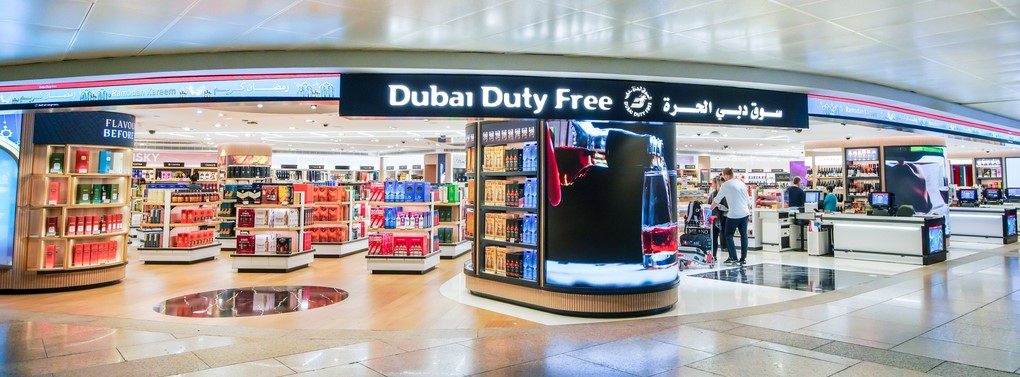
• This updated retail space offers modern fixtures, enhanced digital media displays, and a series of features including ‘Malt of the Month’ plus improved visibility of promotional areas.
• The T1 store does about 40% of DDF’s total arrivals business
• “In terms of productivity, this store is very high,” says DDF Managing Director Ramesh Cidambi. “This year, for example, in less than 600 square metres we have done about AED93 million (US$25.3 million) in business.”
• Whisky, the key category, enjoys prime front of store positioning within the new configuration. Arrivals shops represent 40% of all DDF alcohol sold, 60% of it in whisky.
• Single malt whiskies are key to this store, representing about 35% of the total whisky category, complemented by premium and standard blends.
• A feature wall offers select rare, ultra-premium whiskies (one sold recently for AED110,000/US$30,000) and other brown spirits.
• Promotional offers are key – in June DDF has partnered with Pernod Ricard Global Travel Retail on a blockbuster offer whereby any purchaser of a bottle of Royal Salute gets a Chivas 18 Year Old free. And for every two bottles of Johnnie Walker Gold Label, the buyer gets a third free. A Grey Goose twin pack is currently on offer with a -30% saving.
• Gin, much extended in range in 2022 and 2023, continues to do well, as does tequila (up +60% year-on-year in this store).
• The Champagne zone (below) is anchored by a star-studded LVMH fixture, including Dom Perignon, Moët & Chandon, Veuve Clicquot and Armand de Brignac. As in T3, other Champagne brands have benefitted from the merchandising allure, driving strong growth across the category.
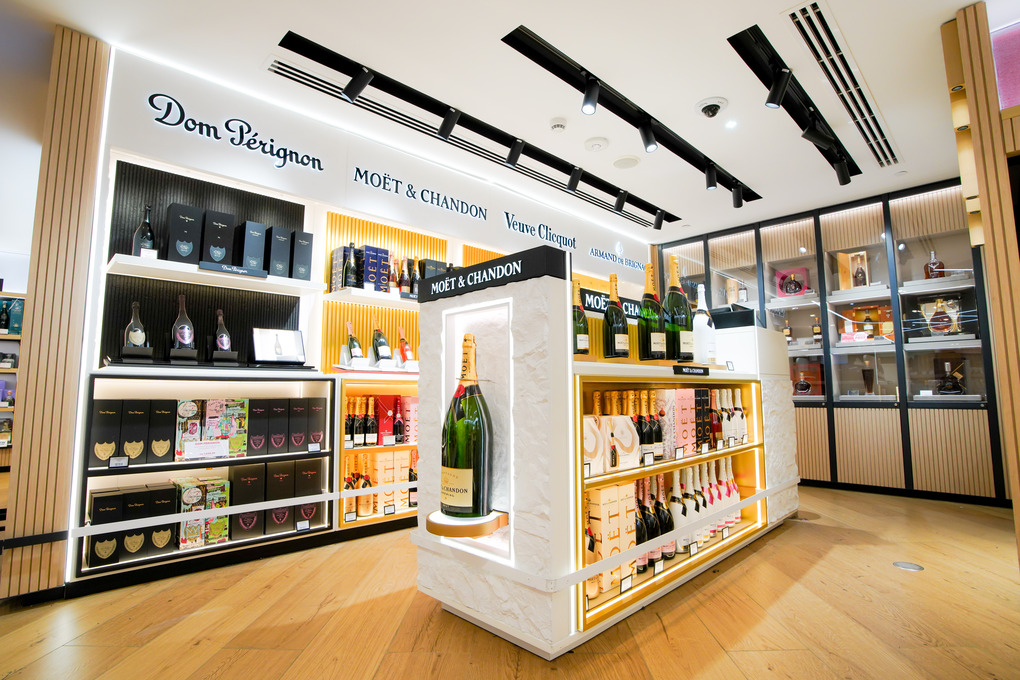
• Wine, as in all three terminals, is superbly well-ranged with 18 countries represented. The offer extends from entry points to the great Bordeaux first growths; cult California label Screaming Eagle (US$4,600 a bottle) and its equally upscale Napa Valley cousin Opus One.
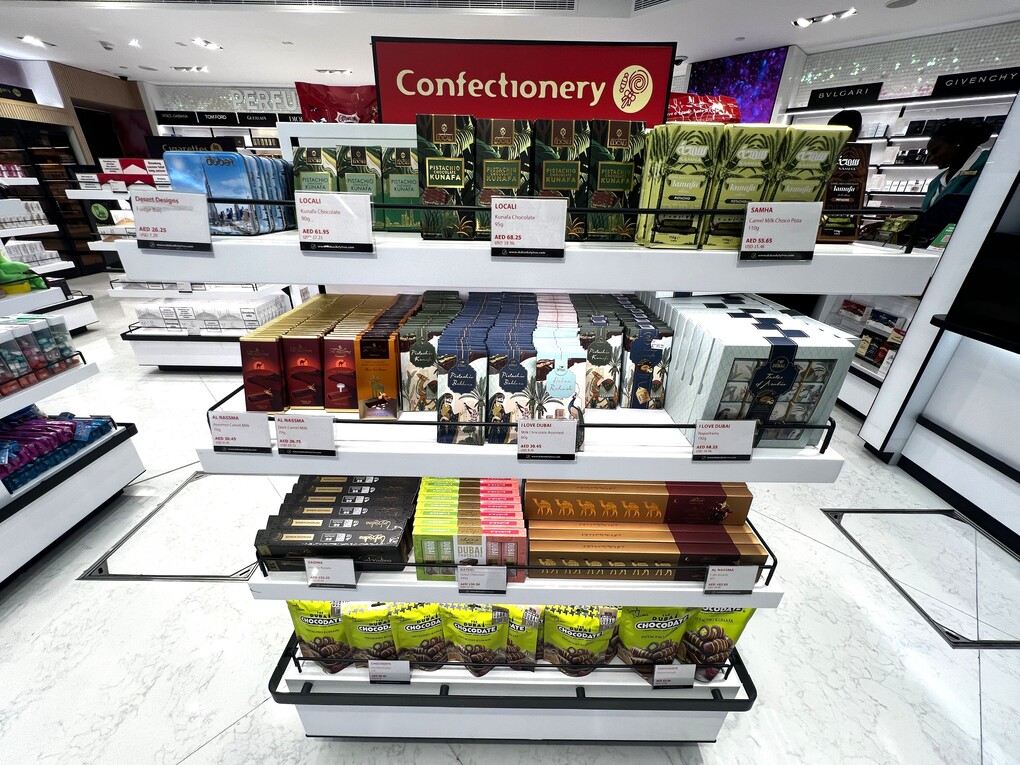
• DDF has extended the non-alcohol categories in the T1 store. Perfumes represent around 7% of sales. Confectionery (spurred by Dubai Chocolate’s performance), tobacco and some accessories top off the offer.

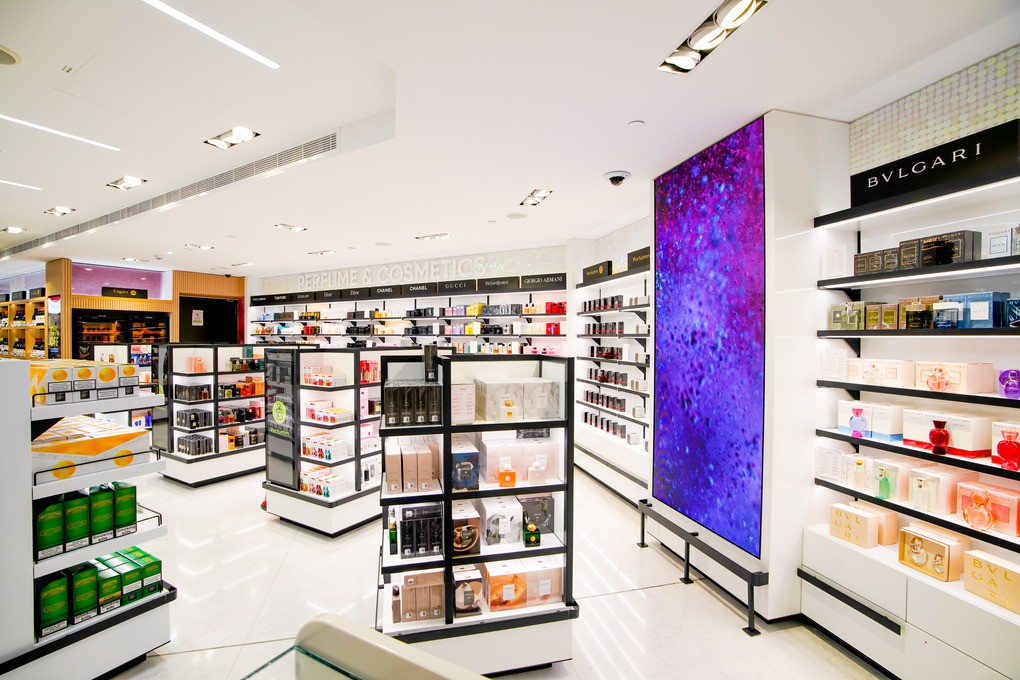
Terminal 1 Soundbites
“The penetration here is a quarter of that we would see in departures. So there is huge opportunity in terms of improving it and thereby increasing sales,” says Cidambi.
“Alcohol is a very competitive category with our friends in India, the domestic market and the northern Emirates, so the purchasing team make sure every month we have at least three promotions we call ‘killer offers’. We are competitive or better than what the passengers see elsewhere.
“We want to keep driving the message that Dubai Duty Free offers great value and encourage people to come in. Once they come through the threshold, the shop is attractive enough for them to buy… but the challenge is to get them past the threshold.” ✈
Terminal 2 talking points
- The store is 302sq m. A key challenge while renovating was the split nature of the shop – alcohol on one side with perfumes & cosmetics and other categories on the other.
- Another big challenge was the store’s limited depth.
- The refurbishment, completed in March 2025, introduces digital screens and an intuitive layout that leads customers through the space
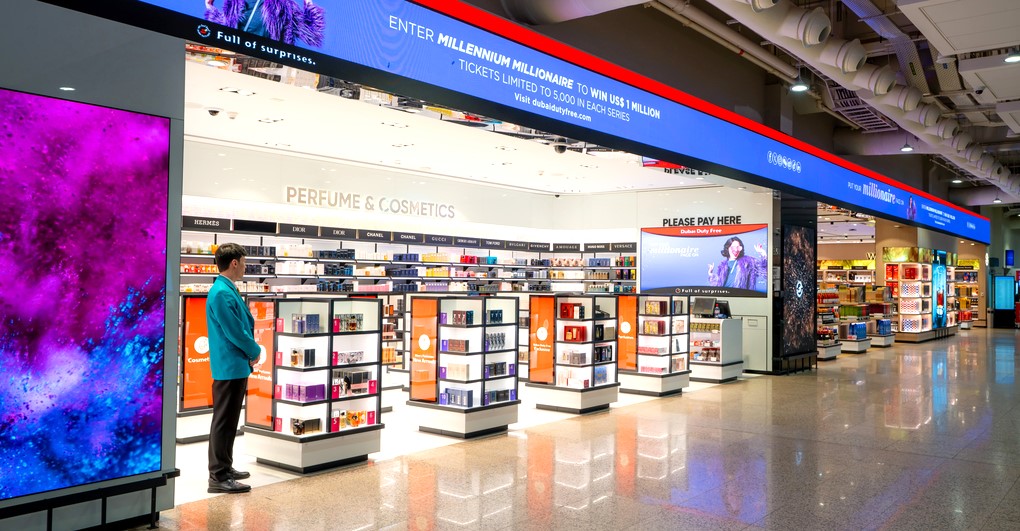
- The T2 shop represents about 15% of total DDF arrivals sales.
- Alcohol in turn constitutes between 75% and 80% of this store’s sales.
- As in the other terminals, wine and Champagne are a critical part of the business. For beer, competition from domestic market rivals is intense.
- Despite the store’s limited space, a strong single malt assortment is offered.
- The store features a limited tobacco offer due to the Federal Tax Authority imposing 100% excise duty on sales of cigarettes in arrivals (not departures) duty-free. The category has also suffered from Saudi Arabia’s recent introduction of duty-free arrivals shopping, including tobacco.
- Additionally, the digital tax stamp differs from that on departures duty-free cigarettes, discouraging producers from producing arrivals-specific packaging, thus further limiting the assortment.
- Perfumes & cosmetics (mainly the former) are important in this store. Although there is almost no customisation, the store is well-ranged and sales are encouraging (+9% year-on-year in June up until the Iran-Israel crisis).
- Another key category, confectionery, has been driven by the extraordinary momentum behind Dubai chocolates, only introduced last October.

Terminal 2 Soundbites
“The representation of the alcohol offer is really important,” says Cidambi. “We lightened the tone of the shop and also made sure the lighting uses less electricity. We have a strong offer and the signposting is excellent, so you can immediately see the different sub-categories within alcohol.
“For people arriving in Dubai, we have managed to inculcate the habit of landing and picking up some wine along with whisky. So we have a fantastic range.
“Overall within arrivals, we have wines from 18 countries. The best representation is in Terminal 3 but the Terminal 2 arrivals offer is still very good.
“All the Dubai chocolates continue to do well,” Cidambi continues. “And partly because of that, confectionery in arrivals is doing better this year. If you add the sales of all Dubai chocolate [in departures and arrivals], it’s about a million Dirhams a day (US$272,000), which is extraordinary. It’s 40% of the total confectionery offer.
“We offer Mars, Toblerone, Lindt, all the big brands. In spite of that, just a few brands and references have captured 40% of the total category. I’m happy to say that it hasn’t slowed down. This year so far, we have sold about AED130 million (US$35.4 million) worth of these chocolates, which is just unbelievable.
“The design aesthetic is very nice, fresh and attractive. And because the façade is so long and the digital screen is about 44 metres, we are hoping everyone whose luggage is on the baggage belts get tempted to walk in.
“This shop is doing about +15% better in June than it did last year. So we hope that trend continues.” ✈
Terminal 3 talking points
- This ‘jewel in the crown’ store is 1,283sq m.
- The elegant shop boasts a wide-open entrance and a massive digital façade to draw passengers toward its disadvantageous position to the right of all baggage belts.
- The store is anchored at the front by its prime attraction, Les Caves de Champagne, created through a strategic partnership with Moët Hennessy to elevate the shopping experience.
- Chilled Champagne is on offer to encourage impulse purchases.
- Fun and social-media-friendly elements, such as ‘Beer Garden’, ‘Wine O’Clock’ and ‘Chill Out Zone’, are designed to appeal to a broad audience, engaging shoppers through interactive experiences and visually striking displays.
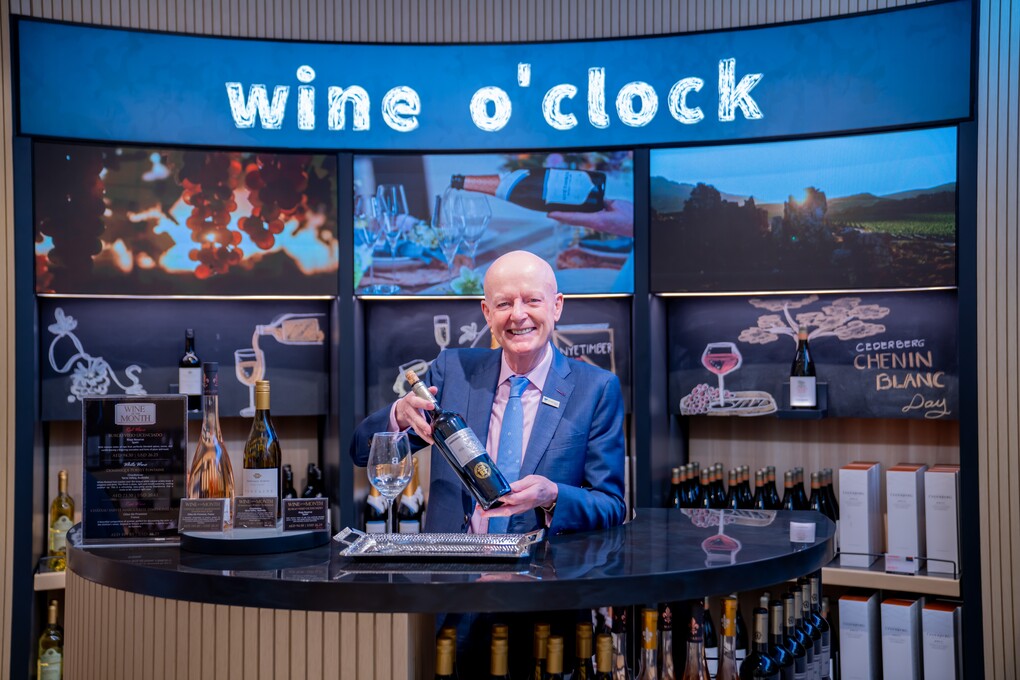
- Clearly defined zones for wine, beer, malt whisky and Champagne add to the key liquor category’s visibility and ease of shopping.
- Liquid to lips: Samplings of wine, whisk(e)y and other spirits are proving crucial to conversion. “For every ten people that we are able to attract to a tasting, five or six of them will purchase. So the conversion rate is very high,” says Cidambi.
- Salon Privé presents a high-end experience featuring a select array of extraordinary wines (including Domaine de la Romanée-Conti) and spirits
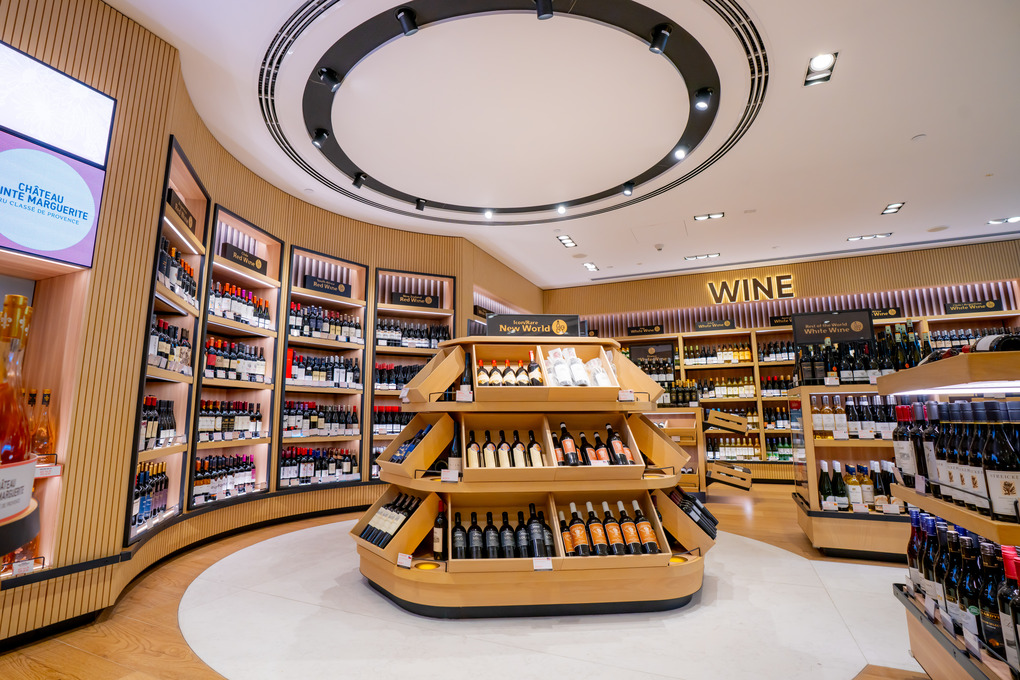
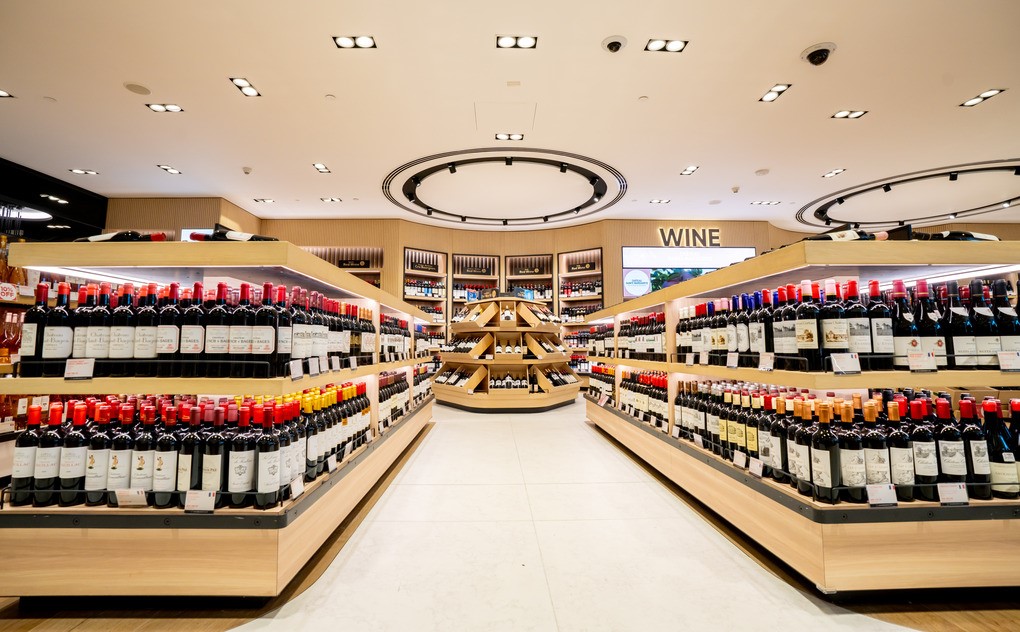

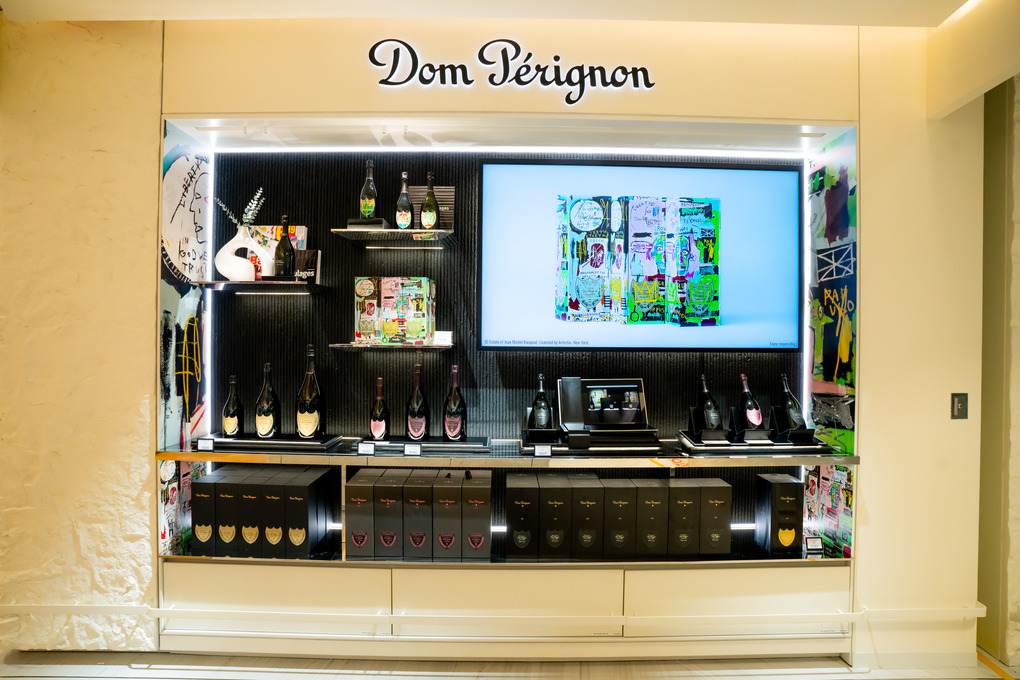
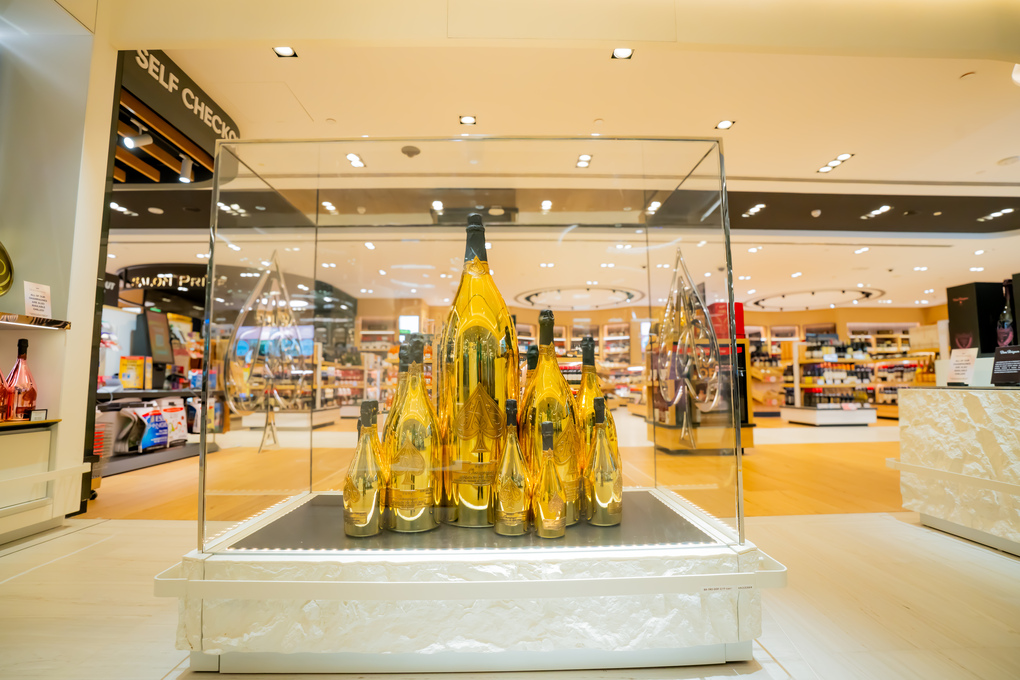
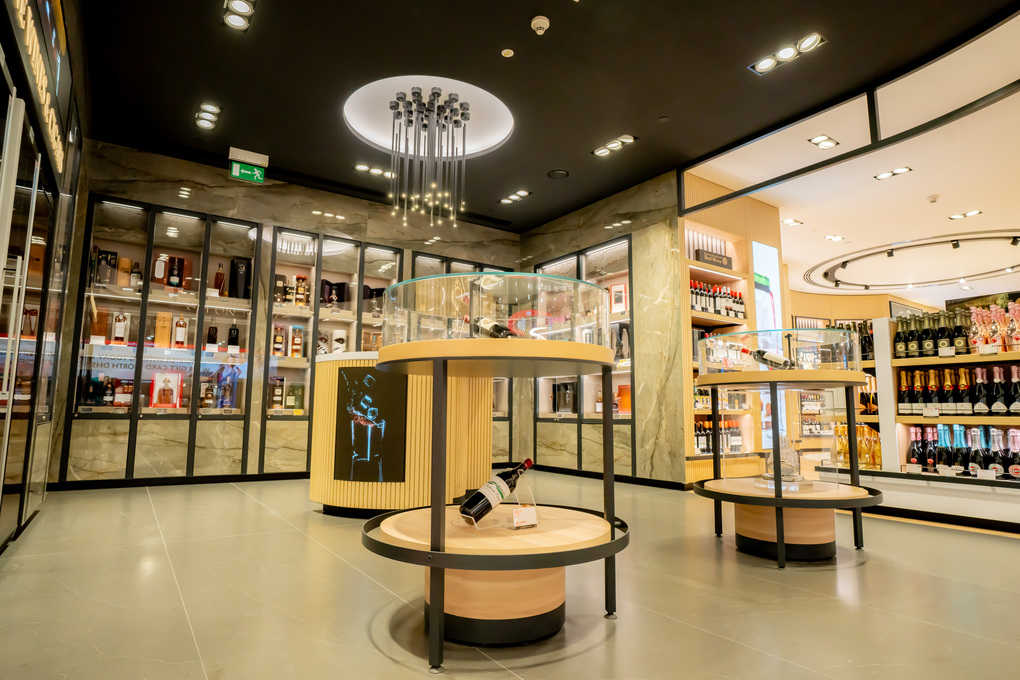
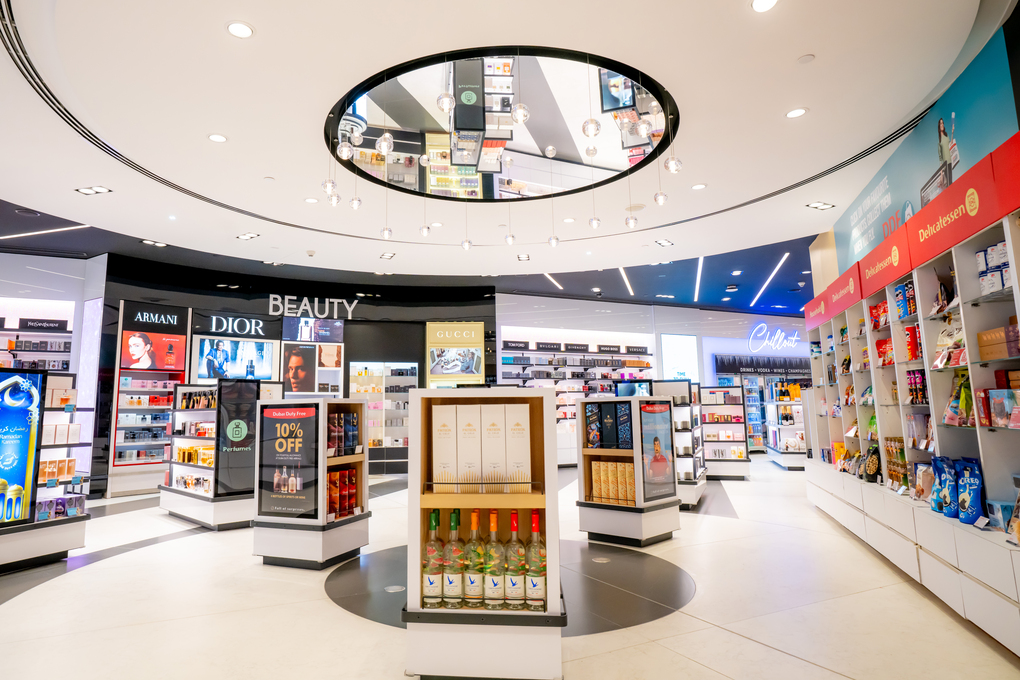
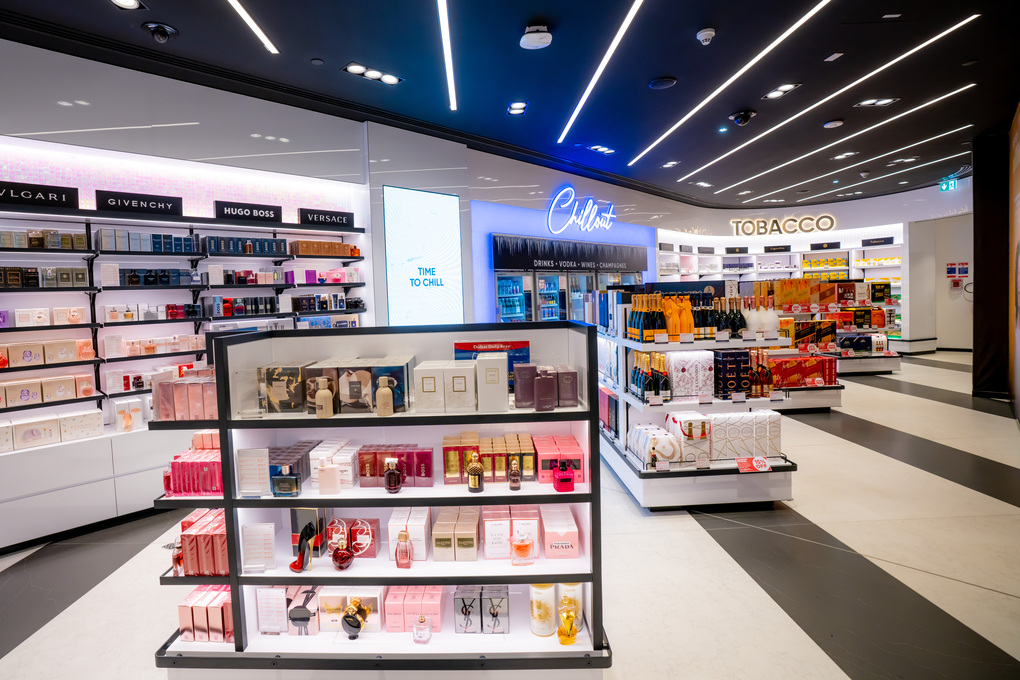
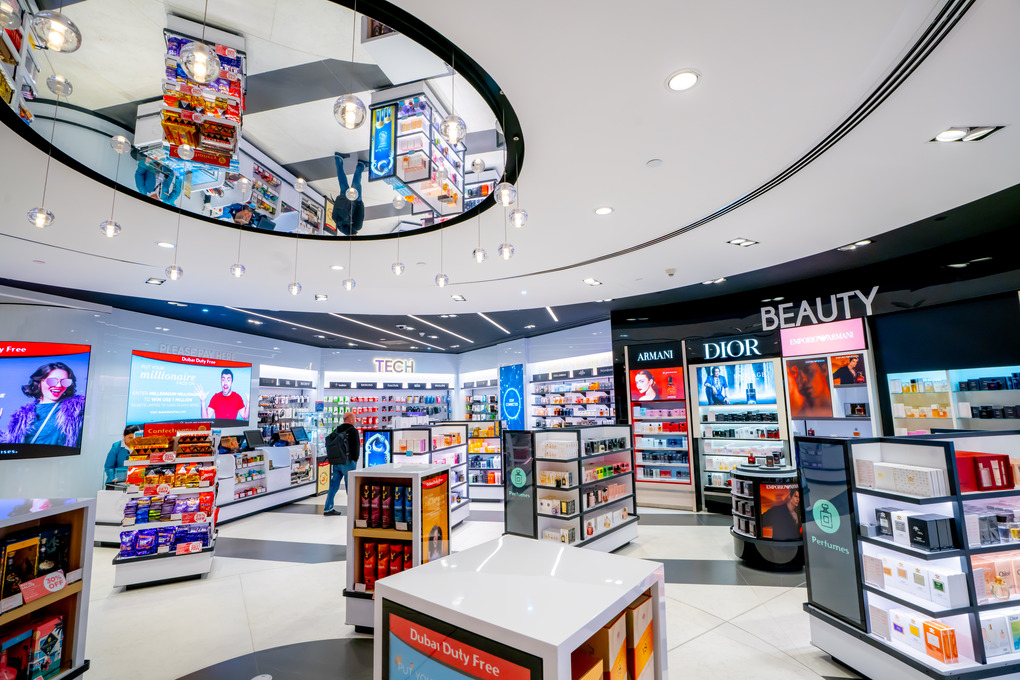
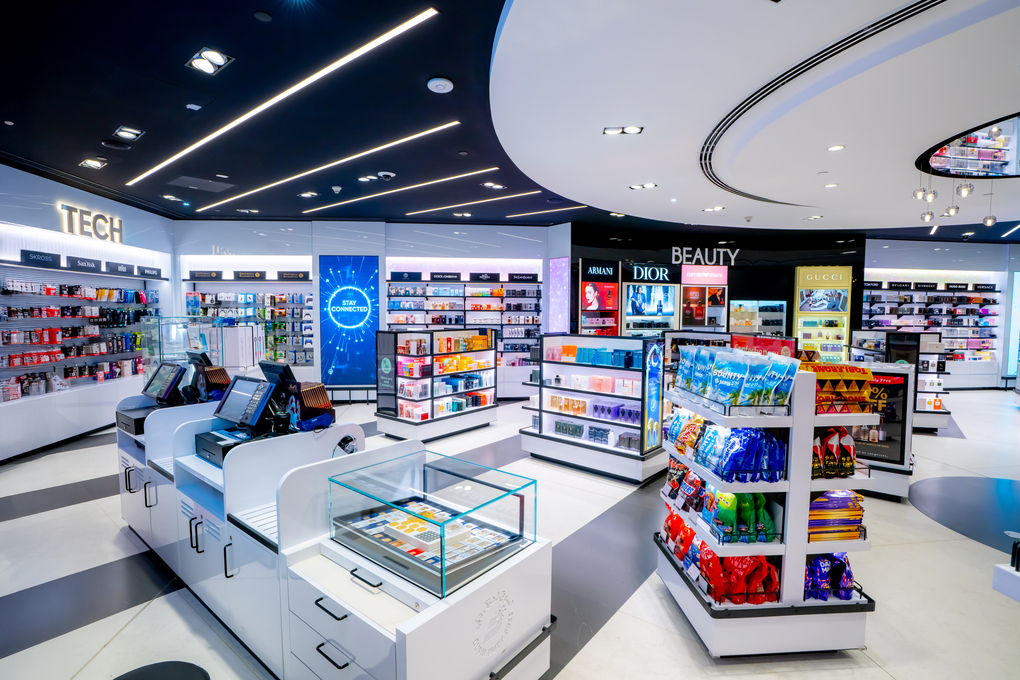
Terminal 3 Soundbites
“The wine offer in Terminal 3 arrivals and particularly in this shop is spectacular. We have more than 1,200 wine references from 18 countries, 40% of which is from France,” Cidambi explains.
“But what I am particularly happy about is that 200 of them are exclusive [within the UAE] to Dubai Duty Free – you can’t buy then in the domestic market and you can’t buy them in the northern Emirates.
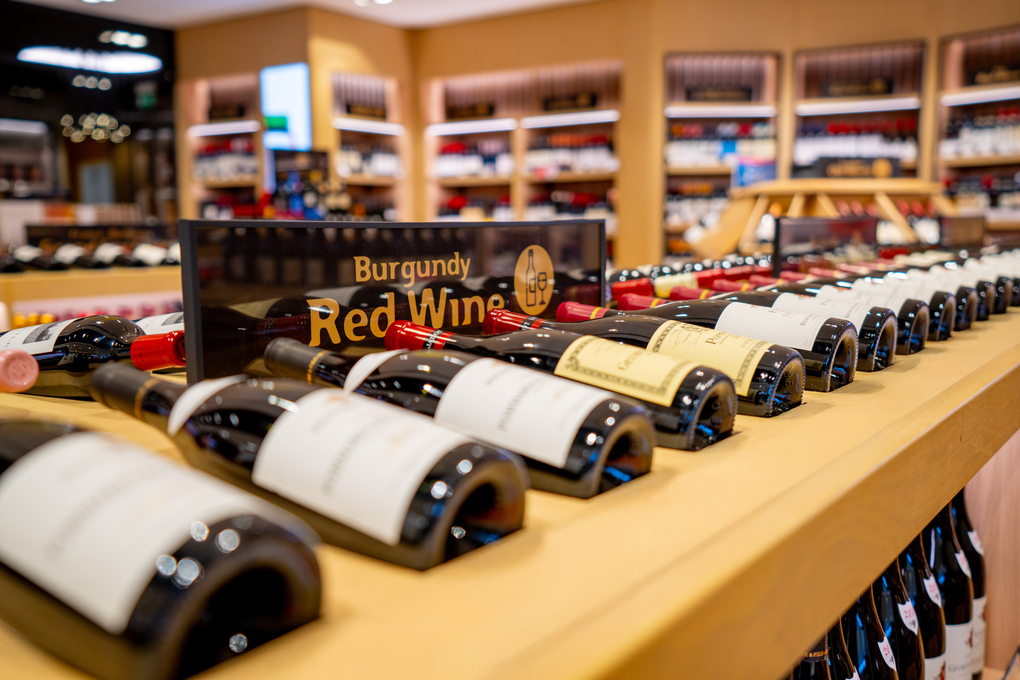
“What we have also achieved with this particular shop is improve the representation of the non-alcohol category. Alcohol is about 70% of total sales, perfumes and cosmetics nearly 10%, confectionery is 4-5%. So it’s a more well-rounded offer compared to what we had before.
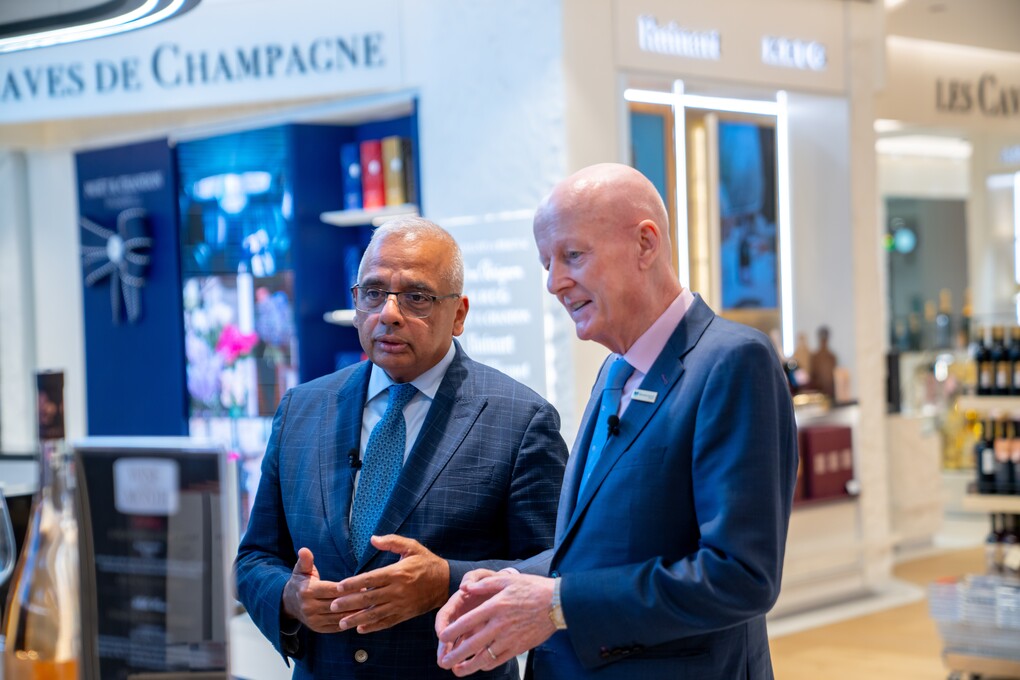
“The shop itself is very spacious, 1,300 square metres of retail. It’s easy to navigate with a trolley even if you have your baggage with you. The circulation areas are wider. Overall, the experience is very strong and we have the impulse categories closer to the checkout.
“We have tried our best to make this a flagship arrival software and something that is truly representative of the Dubai Duty Free retail experience for a passenger who lands on an Emirates flight.” ✈





